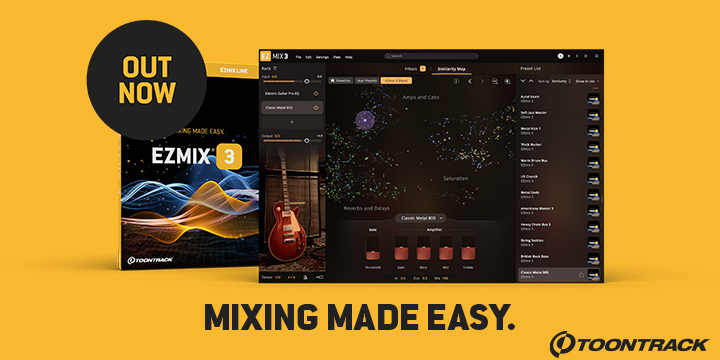
Muse Research, the owner of KVR, has released the version 1.5 software update for Receptor, the hardware VST plug-in player. Version 1.5 also sees the official release of UniWire, initially in VST instrument and effect formats for Windows and Mac OS X (a beta of the AU version will be available very soon).
Several new instructional videos, covering basic Receptor networking and all aspects of using UniWire (including Ableton Live and Steinberg Cubase specific tutorials), are also now available from the documentation page at Plugorama.
New in Receptor v1.5
New feature: UniWire
UniWire is a new way to connect one or more Receptors to a computer-based digital audio workstation using only Ethernet cables - no audio or MIDI cables are needed. In addition UniWire instrument and effect plugins are installed on your host computer, which allow your digital audio workstation to communicate with Receptor as if it were both a virtual instrument and a virtual effect plugin. UniWire also lets you use Receptor's built-in MIDI and audio I/O circuitry as another Audio and MIDI interface for your computer-based DAW.
UniWire is explained in detail in the UniWire Manual Supplement (4 MB PDF). The UniWire VST plug-ins are available as a free download for Windows 2000/XP and Mac OS X (10.3+) for all Receptor owners.
New feature: Snapshot Banks and Patches
Receptor has a new type of "Multi Patch", called a "Snapshot Patch". All related snapshot patches are saved together in a "Snapshot Bank". Specifically, all "Snapshot Patches" within a "Snapshot Bank" share the same plugin assignments and patch data, which are stored in a hidden 'parent' file. The only differences between the snapshots in a Snapshot Bank are their mixer settings (volume, pan, mute, bypass, etc.).
There are several advantages to using snapshots rather than traditional Multi patches. The biggest is at you can switch between snapshots very quickly without any interruption in the sound. Unlike a Multi patch, which must instantiate every plugin (not previously Z-loaded), plus all the parameter data for each plugin, this data is only loaded once and is re-used by all snapshots in the Snapshot Bank. This can be particularly useful when you're switching between patches that use different samples, since sample data can take a substantial amount of time to load into RAM.
Snapshots are explained in depth in the version 1.5 release notes (2.1 MB PDF)
New Feature: Program Change Targeting
You can now, in Setup View, tell Receptor to ignore all incoming Bank Select (MSB/LSB) messages and, if those messages are ignored, which patch bank receives the incoming Program Changes.
New Feature: Last Program Change
Receptor now displays the last Bank Select and Program Change messages it received and the MIDI channel on which those messages appeared. This is particularly useful when you're setting up a MIDI keyboard controller for Receptor and are trying to figure out what Bank and Program Change messages the controller is sending, and on which channel it's sending them.
New Feature: Additional Key Commands
Muse research has added several new key-commands to facilitate stepping through Multi patches, Single patches and Source plugin patches from a computer keyboard. These key-commands operate the same as if you clicked the corresponding "Next Patch" and "Previous Patch" buttons in the graphical user interface.
Modified Feature: Plugin Tools Button
The Register Plugins button, introduced in receptor v1.3, has been renamed the Plugin Tools button. It performs all the same functions as previously described – that is, if you employ the "User Installable" method to install a supported plugin, you would then click the Plugin Tools button to launch that plugin's authorization / registration tool.
Receptor 1.5 expands the function of this button to support additional plugin helper applications that may perform functions other than registering "User Installable" plugins. For example, if you install the Ivory plugin, you may need to run the included "Ivory Library Tools" tool for sample verification, conversion, etc. You would do so by launching it from the menu that appears when you click the Plugin Tools button.
Modified Feature: Route MIDI CCs to Source Plugin
In previous versions, when you enabled this option, Receptor would automatically take all 128 incoming MIDI CC messages and route them to the plugin assigned to the Source slot. This has been changed as follows:
- If the Program Changes parameter is set to Use Bank Select, then Bank Select messages (CC 00 and CC 32) are not routed to the Source plugin and, instead, are used by Receptor as Bank Select messages. This means you can enable the Route MIDI CCs to Source Plugins feature and Receptor will still respond to Bank Select messages.
- If the Program Changes parameter is set to Ignore Banks Select and Target <blank>, then Bank Select messages are routed to the Source plugin because Receptor no longer needs to reserve these messages for Bank Select purposes.
Removed Feature: System Temperature Monitor
Under critical listening conditions, the System Temperature monitor (which was added in Receptor v1.4) could cause minor clicks in the audio signal. As the temperature monitor was basically an informational tool for Muse Research engineering, it has been removed from version 1.5.
If you want to know a bit more about these new features please see the version 1.5 release notes (2.1 MB PDF).



 Other Related News
Other Related News